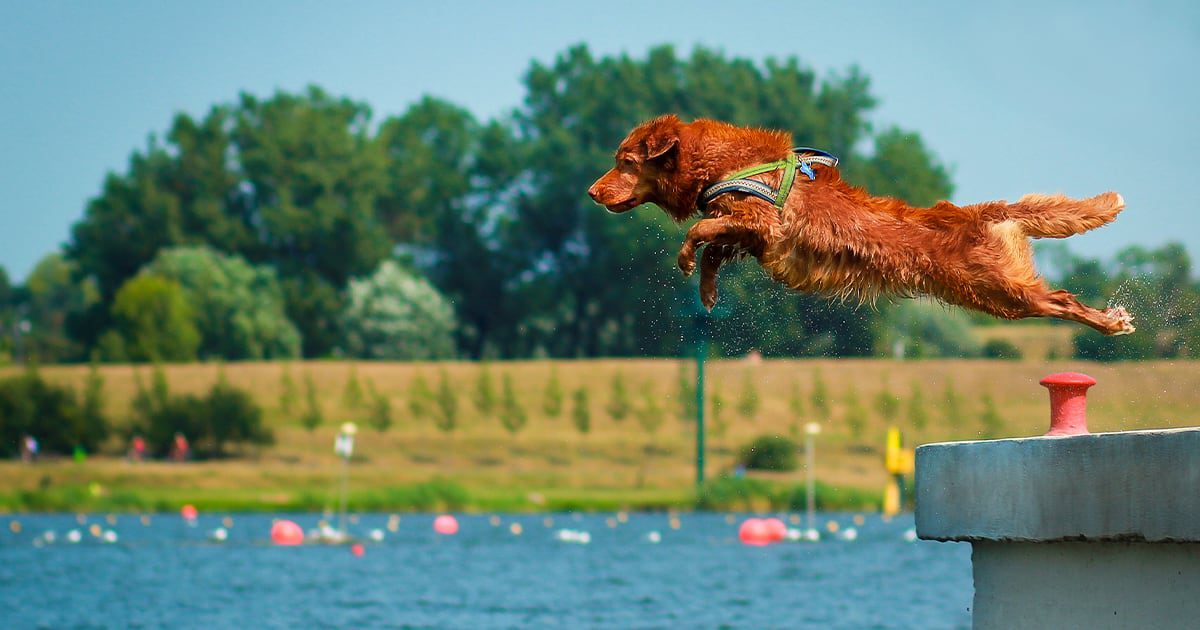The flies are buzzing, the grill is sizzling, and everyone’s diving into the swimming pool — it’s the perfect summer scene. But while you’re soaking up the sun and splashing around, there’s no reason to leave your dog on the sidelines. With a few simple swimming pool safety tips, your furry friend can join the fun too. By making sure your pup is supervised at all times, they know how to safely enter and exit the pool, and they’re wearing a properly fitted dog life jacket (if needed), you can help prevent accidents and ensure a safe, tail-wagging good time for everyone.
Dog in the Water!
Don’t assume that your dog knows how to swim — many breeds can paddle and are bred to swim easily, but that does not mean they are confident or safe in or around a pool. Even if they are able to swim, they can still become fatigued or disoriented and experience distress. Make sure when you’re introducing them to a pool for the first time that you are aware of their body language. If they are stressed or refuse to go in or near the swimming pool, don’t force them.
Start slow and introduce swimming one step at a time. Swimming lessons should begin with the shallow end of the swimming pool. Show them how to use the steps or ladder to get in and out of the pool. Keep initial swim lessons short and gradually increase the time to help build their stamina and confidence safely.
Additionally, make sure your dog can follow basic obedience commands like “come” and “stay,” which are crucial for safety in and around the pool or any body of water. These commands are an important part of dog swimming safety when managing your dog around water and can help prevent accidents.
If you have a pool at home, it’s a good idea to install a secure fence around it to prevent your dog from taking an unsupervised swim. Make sure the fence is properly installed and high enough to prevent jumping, with no gaps that could allow digging underneath. As a responsible pool owner, you might also consider adding extra safety measures like a pool alarm or a sturdy pool cover for added protection.
Can Dogs Swim in Chlorine Pools?
While chlorinated swimming pools are generally safe for dogs in moderation, chlorine and other pool chemicals can have negative effects. Short swims are usually fine, but frequent or prolonged exposure can irritate your dog’s eyes, ears and skin.
If a dog drinks water from a chlorinated pool, the chlorine levels in well-maintained pools are typically low enough not to cause harm from incidental ingestion, but swallowing large amounts of highly chlorinated water can lead to stomach upset or other health issues. More seriously, pool maintenance chemicals — like chlorine tablets — are highly toxic if ingested. Always store these products securely, well out of your dog’s reach.
After swimming, rinse your dog thoroughly with fresh water to remove any chlorine residue from their coat, skin and eyes. It’s also important to gently dry your dog’s ears with a towel to help prevent moisture buildup that can lead to ear infections.
Can Dogs Swim in Saltwater Pools?
Yes, dogs can swim in saltwater swimming pools, and many pet owners actually prefer them over traditional chlorine pools. Saltwater pools have lower chlorine levels, which can be gentler on your dog’s skin, eyes and coat. However, they still require some caution. Ingesting large quantities of saltwater can cause gastrointestinal upset, electrolyte imbalances and can potentially be fatal.
While the salt concentration is much lower than in the ocean, it can still cause skin irritation. As with chlorinated pools, after swimming, rinse your dog off with fresh water to remove any salt residue and prevent skin irritation. Prolonged exposure to salt can strip natural oils from the skin and coat and cause itchiness and flaking. It is also important to rinse your dog’s eyes and dry their ears thoroughly to prevent infections and irritation.
Is Pool Water Bad for Dogs?
While the occasional sip of chlorinated pool water is unlikely to cause serious harm, drinking pool water in large amounts can definitely make your dog sick. Pool water, even though a filtration system, contains chlorine and other chemicals that, in excess, can irritate a dog’s digestive system and lead to symptoms like vomiting, gastrointestinal upset, drooling or lethargy. In more severe cases, it can even cause electrolyte imbalances or more serious health issues. Make sure to monitor dogs with preexisting conditions.
It’s important to monitor your dog closely while they’re near the pool — provide a bowl of fresh water to drink nearby to discourage them from lapping up pool water, and watch for any signs of discomfort or unusual behavior after swimming. If your dog shows symptoms like vomiting, excessive fatigue or a sudden loss of appetite after being in or around the pool, it’s best to contact your veterinarian immediately.
Do Dogs Need Life Jackets?
Having a flotation device or dog life jacket is a great way to allow your pup to have some fun while still exercising caution. While many dogs are natural swimmers, not all dogs are equally strong in the water — some may tire easily, have dense body structures or simply lack swimming confidence. A dog life jacket or dog life vest helps keep your dog safe by providing additional buoyancy, reducing the risk of exhaustion or drowning. Before heading into the pool, lake, ocean, or any body of water that requires swimming, it’s important to ensure your dog is wearing a properly fitted dog life jacket with secure straps and a handle on the back for easy lifting, if needed. Also, consider a dog life vest or jacket with reflective trim or a bright color to help with visibility. A dog life vest not only adds a layer of protection but also gives you peace of mind, letting both you and your pup enjoy aquatic adventures with confidence.
More Water Fun Ideas
Swimming is a low-impact exercise, making it great for older pets or pets with health issues like arthritis and hip dysplasia. Unlike running or jumping, swimming allows dogs to move freely without putting stress on their joints and muscles. The buoyancy of the water supports their body weight, reducing strain while still providing a full-body workout in a fun way. Be sure to consult your veterinarian before starting any new exercise routine, especially if your dog has a medical condition.
For dogs who are obsessed with chasing balls or sticks, water fetch is an obvious choice. All you need is a floating toy and a good throwing arm. To mix things up, you could also play “keep away” with a floating toy. If your dog is an expert swimmer, they might be able to go deep diving and retrieve a toy from the bottom of the pool.
Staying Safe in the Water
Playing in the pool is lots of fun, but it’s also important that you keep your dog safe while they’re in and around water. Make sure you are supervising them at all times and you’re available to help if they get into trouble. If your dog is a brachycephalic (flat-nosed) breed, you may want to avoid deep water. With their barrel-shaped chests, short legs and tendency for breathing challenges, these breeds aren’t really built for swimming. Also, if your dog has health issues, it’s best to check with your veterinarian and confirm that it’s safe for your dog to participate in water activities.
There are a few potential health issues associated with water activities that hopefully you will never encounter, but it’s good to be aware of them. While rare, dogs can experience respiratory distress after inhaling water. Symptoms may not appear immediately. If your dog has a near-drowning incident, seek veterinary care right away, even if they seem fine.
Another concern is that your dog could get too hot while playing in the sun and water. Look out for heat-related health problems like dehydration, sunburn, burned paw pads (from paved surfaces), heat exhaustion and heatstroke. Always make sure you have fresh drinking water for them around the pool area. There are simple ways to protect your dog from the sun, but on really hot days, it may be best to skip the water fun and play indoors instead.
On long, hot summer days, taking your dog for pool time is a great way to cool off and get some exercise. But just remember to take precautions for a fun and safe day for everyone.







